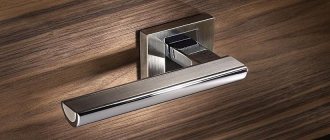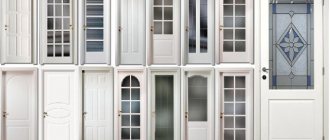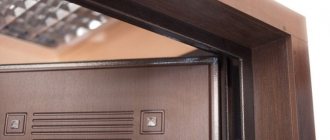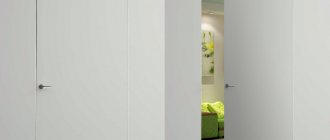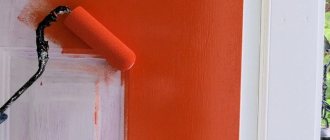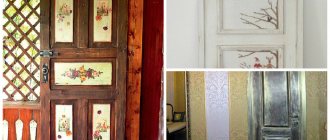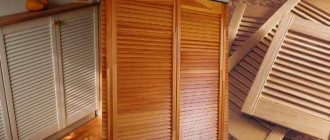Interior doors made of wood are not cheap, they look presentable, solid and are quite durable. But over time, their appearance deteriorates, and noticeable damage appears on the surface. Restoring interior wooden doors will help restore the coating and restore attractiveness. You can do this work with your own hands. It is not difficult. You just need to know the recovery methods and take into account some nuances. Then the restored product will look no worse than a new one from the store.
In what cases does it make sense to undertake restoration?
It would seem, why bother with an old wooden panel if now you can easily buy a new door? However, if you dig deeper, there are several reasons:
- The first, and perhaps the main reason, is the price. For reasonable money, you can only buy a hollow box, decorated to look like wood, which will last a maximum of 5–7 years, after which it will “fall apart” irrevocably.
- Restoring a wooden door with your own hands makes sense if you decide to change the overall style of the room, and the wooden panel simply does not fit into the color scheme.
- Restoring old doors is justified when the design is of real artistic or even historical value. Simply put, when your door is an antique.
Classic wooden door.
- It’s also worth tinkering if you know for sure that the canvas you restored will become the pearl of the interior, an exclusive thing made with your own hands.
- Many doorways and door panels do not meet modern standards, and updating old wooden doors will cost several times less than manufacturing the same structures to order.
- Lastly, many people get into this hobby simply because it is a great and very rewarding hobby.
As for prohibitions, they practically do not exist. The only thing that even professionals don’t take on are doors that are seriously damaged, have large holes on the surface or parts that are completely rotten. In this case, it is very difficult to renew a wooden door; it is cheaper to buy a new one.
Replacing cracked glass
Cracked or simply outdated cloudy glass is not difficult to replace with your own hands. In its place, you can install a new one, for example, matte or transparent, tinted or with a sandblasted pattern, embossed or smooth, colored or plain.
Note! If the glass has a thickness of 10 mm (triplex), then replacing it is impractical. Firstly, it is very expensive, and secondly, it is almost impossible for an inexperienced person to cope with such a task on their own.
Case 1. Glass fixed with glazing beads
The easiest way is to replace glass secured with glazing beads. It is enough to dismantle them and then remove the glass by hand. We arm ourselves with pliers and a metal spatula. We pry up the glazing bead with a spatula, and use pliers to carefully pull out the nails.
Use a chisel or knife to clean the glass bed. We take measurements. If the opening is non-standard, we make a figured pattern from cardboard. At the same time, we take into account that the size of the glass should be slightly smaller than the opening. We wipe the glass with a soapy sponge, dry it with a clean rag, transfer the design from the pattern and cut it.
Attention! Wear gloves to avoid cutting your hands. Carry out work on a flat surface with a working glass cutter.
We treat the perimeter of the glass opening with sealant, after which we insert the cut piece, saw new glazing beads with a jigsaw and fasten them with thin nails.
Case 2. The glass has a hidden fixation
If the glass has a hidden fixation, you will have to disassemble the door, unscrewing the bolts, removing the old glass and inserting the new one. Silicone cannot be used in this case, since it will be impossible to replace it later. A significant disadvantage of replacing glass in such doors is that after assembly, the panel may lose its geometry and will require editing with a plane.
By the way, instead of glass, you can use an acrylic unbreakable mirror. It is quite light, durable, highly decorative and easy to cut.
Find out about the 10 best options for making door decor with your own hands from our new article.
Required tools and materials
When repairing old interior or balcony doors, it is necessary, first of all, to carry out preliminary work, preparing the surface for work.
Some tools will help you with this:
- Solvent suitable for the door covering material;
- Construction hair dryer, iron or blowtorch;
- Skin with large and small crumbs;
- Sander;
- Screwdrivers, hammer, knife, pliers, film.
For the renovation work itself, you need a spatula, glazing beads, putty, stain, varnish, paint, impregnation, paint brushes, sponges, rollers, door lock, hinges.
Subtleties of the process
Old or damaged interior doors are subject to restoration. The cause of mechanical damage can be, for example, a fire. High humidity can also negatively affect wooden panels. Mechanical damage often occurs after opening the doors using improvised tools. When restoring a product, it may involve replacing the door leaf, updating the door jambs, painting or tinting the surface.
To restore functionality, it is often necessary to update the fittings or locks. In case of minor damage to interior doors, restoration work can be done with your own hands.
It is better to entrust the repair of original doors to a specialist in this field. The work should also be left to a professional if the restoration requires replacing the door frame or repairing the entire door frame.
For your information, some advantages and features of restoration of interior doors are presented:
- It is more profitable to repair doors made of solid wood, bringing them into proper and working condition, rather than spending your budget on a new product.
- They update an old door when changing the interior style of the house. The procedure is carried out even when the canvas is still in excellent condition and does not yet need to be replaced.
- Restoration of old wooden structures is carried out when the door leaf and door frame are handmade and have a unique ornament and texture.
- Decorating the surface of the doors with your own hands will allow you to create a unique product that will harmoniously decorate the entire interior.
- An interior door must be repaired when replacing the door may compromise the integrity of the opening or wall cladding.
- Due to the non-standard size of the old door, it is better to carry out restoration work than to carry out a labor-intensive replacement of the product.
- Restoration is convenient, since replacing a product is often accompanied by replacing the entire door frame. This procedure will definitely create the need to seal the resulting cracks, plastering and gluing wallpaper around the doorway.
To work independently you will need a lot of free time. Step-by-step implementation of all procedures will be the key to successful restoration of the door leaf.
The successful use of techniques for restoring a product, first of all, depends on the characteristics and properties of the door leaf material.
Eliminating deformation of a wooden door frame
The tree is characterized by an increased susceptibility to light damage.
For this reason, repairs to interior structures made from this material often involve correcting defects in the frame, frame, additions, as well as the face and other fittings. The main causes of deformation include:
- Sagging of the canvas.
- Poor closing and opening of the interior door.
- Formation of gaps.
If one of the guide strips deviates, it must be replaced. Ignoring the damage in the near future will lead to diagonal displacement of the canvas, rubbing and deformation of the rack. All this will already cause the need to repair the adjacent wall.
Reference . Measuring its sides with a plumb line or comparing the upper and lower corners will help identify distortions in the door frame.
Materials
Previously, interior doors were made exclusively from solid natural wood. Currently, door panels include polymers and glass. The surface can be coated with high-quality varnish or laminated. Oak doors or beech products are premium door leaves that have an elegant natural texture and come in a variety of shades.
Increased strength and durability make such interior products desirable and practical. Only the price due to these advantages is very high. Carrying out work on the restoration of products is much more economical than replacing the entire canvas.
The most popular material in the manufacture of canvases is fiberboard. Methods for restoring such doors differ from restoration work on products made from solid natural wood. To remove a layer of old paint from the surface of a fiberboard product, an iron and a hair dryer are used. Considering the fine structure of the surface of the product, grinding work is carried out only using fine sandpaper.
Using finishing elements, slightly changing the surface relief, you can get an analogue of paneled fabric. Expensive models consist of dense tile material. The quality of the surface finish of the product determines the cost of the product.
Innovative veneer veneers are often used. The basis of the door will be inexpensive pine material, lumber or particle boards. Under the influence of temporary changes, veneered products may lose the integrity of the top layer. To restore such doors, special wood glue is required. When using glue, you must also take into account the favorable temperature conditions and avoid humidity. Violation of this regime can negatively affect the veneer surface, which leads to swelling and peeling of the material.
The use of metal structures in the house is not for everyone. Iron doors also tend to wear out, unless, of course, they are armored products. Even on high-quality canvases, over time, the external finish deteriorates, locks break, and fittings fall apart. Long-term operation significantly affects the appearance and design mechanism of such doors. In iron interior structures, aluminum or stainless steel is mainly used. Metal parts are successfully combined with other materials.
If you purchase a new door, high-quality metal products are expensive. Therefore, it will be much more profitable to repair the old door. Based on the experience of professionals, it can be noted that any type of metal door can be restored. Professionals can replace hinges, handles and locks in accordance with the color scheme of the door leaf to be restored.
To ensure the restoration is completed correctly, it is recommended to use only high-quality components and locks. The further service life of the product will depend on this selection.
Options for different models
One can confidently classify the “Stalinist” door as an antique. Indoor products from this era are usually double-leaf, often with glass inserts. In the “Stalin” style, the products are heavy and bulky, which makes restoration work a little difficult. A professional craftsman can easily select modern material for their cladding, the necessary fittings and type of decoration.
Door leaves and the surface of historical “Stalinist” doors are usually wooden. If the cause of damage is not mechanical impact, then abrasions are the influence of time. Restored wooden doors should have an aesthetic appearance. Craftsmen will help you choose the main material and finishing material, giving a laconic look to antique doors.
In an apartment with an atmosphere of Provencal or Scandinavian interior style, the restoration of doors is also decorative. Finishing with patina and painting will turn an ordinary old white door into a stylish decorative element. The presence of frames and crossbars characterize a prefabricated interior door, which is also called paneled. For example, panels can be in the form of MDF sheets or glass inserts. This way it is possible to create figured elements and make the appearance of the canvas quite interesting. Restoration of paneled doors implies preservation of existing reliefs or complete replacement of the surface of the product.
This option is suitable for offices, bathrooms and toilets, balconies and other rooms with high humidity. Economical and moisture-resistant models are indispensable for such premises.
Glass is often used as an insert; there are also options for completely transparent doors for the newfangled living room interior, for example. Only types of glass sheets with special textures are used. For safety reasons, the material must have a protective film and not form sharp fragments when broken, which is also taken into account when restoring such paintings.
Rules for restoring a metal door
Not only wooden doors can be restored. Metal entrance doors that have lost their appearance are also being improved.
Restoration of a metal door
Step one. The metal sheet is removed and laid horizontally. This makes it easier to carry out all subsequent work.
Step two. You can cover it with masking tape, or better yet dismantle it:
- peephole;
- door handle;
- all other fittings.
Step three. Using a drill or wire brush, remove any signs of corrosion. The surface is sanded with sandpaper with a grain size of 80-150. After this, the canvas should be vacuumed and treated well with a solvent.
Step four. Using car polish, the entire door is treated.
Polish for cleaning stainless steel
For your information. Wood putty is not applicable here, because its adhesion to metal is weak.
Car polish hides all kinds of micro-scratches and small dents that are revealed after removing the rust. The polish is smoothed out with a spatula. The composition dries in about 30-40 minutes.
Step five. The entire surface of the door is polished with sandpaper (selected with 400 grit). The canvas is wiped with a damp cloth, always clean. After this, the surface is degreased. White spirit, another degreaser, is used.
Step six. The door is coated with an anti-corrosion primer (for metal). Use either a narrow brush or a roller. When the primer layer is completely dry, you need to sand the canvas using sandpaper.
Restoration of a metal door
Step seven. Metal paint is used to paint the door. Paint is applied in several layers. After applying each new layer, you should wait until it dries. You can paint:
- brush;
- roller;
- spray gun.
Cleaning and painting the door frame is done in the same way. After completing the work, remove the masking tape and replace the fittings. You can hang the door leaf in place.
Sometimes not the entire surface is restored, but only the damaged area. Then you will need to select paint of exactly the same tone as the remaining sections of the door structure.
For step-by-step instructions on installing a metal door, see here.
We are preparing a wooden door for restoration. Removing fittings and paint
The first thing to do is to carefully remove the door from its hinges and place it on the floor or four stools.
Hinges can be invisible, mortise, screw-in, card removable or non-removable. Since the entire door leaf will be restored, the hinges must be temporarily completely dismantled. To do this, unscrew all the bolts and caps, pry the door from below with a crowbar, lift it, remove it and set it aside.
In addition to the hinges, you should remove all other fittings that will interfere with further work.
Video - How to quickly remove a door from its hinges
How to remove paint. Method one - grinding
If the door is flat and there are a lot of layers of paint, you should take the canvas outside and try to clean it with a sanding machine. The work is quite dusty, the grinding wheels quickly become clogged, but the result will not be long in coming.
The second method is the use of chemistry
You can find various solvents and old paint destroyers on sale. One of them is B52. Operating principle: wetting the surface, waiting, cleaning the peeled coatings with a spatula.
In addition to the fact that this work is very difficult and harmful (solvent vapors are unsafe for health), it is worth noting that chemicals cannot cope with a large number of layers of old coating. Therefore, this method is only suitable for cleaning small areas of the door with a thin layer of old paint.
You can make your own paint remover mixture by mixing caustic soda, water and oatmeal to a thick consistency. This slurry should be distributed over the canvas, and after 30-50 minutes, cleaned off with a metal spatula along with the swollen paint layer.
It is important to use gloves and a respirator!
Method three - using a gas burner
For fire safety reasons, work should only be carried out outdoors. Paint heated by a torch comes off easily, but at the same time it can smoke and emit pungent odors.
This method is applicable only if you know how to handle a burner, have prepared a sufficient supply of cylinders and are ready to warn your neighbors about the upcoming work.
Method four - using a hair dryer
This method is the most productive and safe. Even if there are layers of paint on the door that were applied several decades ago, they will peel off easily, and there will be no burning or chemical smells during operation.
Heat the paint and scrape it off with a sharp spatula. Be careful not to damage the wood. Do not lean over the door, as the air temperature is about 600 degrees.
Method five - soft blasting
The method involves gentle, careful removal of complex contaminants and old paint and varnish coatings from metal, glass, and wood. In this case, the door leaf will not be damaged. When working in conjunction with a jet of compressed air, Armex biodegradable cleaner will be applied to the surface of the door.
The main disadvantage of this seemingly ideal method is the inability to perform work at home, the need to deliver the door to a workshop and the associated costs.
Method six - Using a drill and attachment
Stores sell special abrasive brush attachments that fit onto the drill. Metal fibers will remove old paint, but may damage the wood of the canvas. To process the entire door, you may need not one, but several replacement nozzles, the cost of which is 120-170 rubles per piece.
Video – Soft blasting
How to extend the life of the coating?
To ensure that veneer doors last longer and remain like new, they must be properly cared for. Veneer should not be cleaned with abrasive compounds, otherwise micro-scratches will remain on the surface and it will quickly lose its shine. It is not recommended to install veneered doors so that they are constantly exposed to direct sunlight. This will cause the coating to fade; veneer doors will need to be renewed quite often: varnished or painted.
You can wipe the veneer with a damp cloth, but it must be wrung out well. This material cannot be literally washed with water or used in high humidity conditions. You also need to be careful when washing floors, since this can cause damage to the lower part of the sash and frame. Periodically, to add shine, it is good to polish the structure with wax-based products (polishes). They repel dust and mask minimal defects.
Veneered doors, if properly cared for, will last for a decade. But even in this case, minor scratches and damage cannot be avoided. Therefore, you need to know how to update a veneer door with your own hands. This is easy to do with inexpensive materials and simple tools.
Care Tips
In order for a veneered door leaf to last as long as possible and look like new, it must be properly looked after. It is forbidden to clean the veneer with abrasive materials, otherwise small scratches will remain on the coating and it will quickly lose its gloss. It is not advisable to install veneered doors in such a way that direct sunlight always falls on them. This will cause the cladding to fade; veneered doors will have to be updated quite often: apply varnish or paint.
It is allowed to wipe the veneer with a damp cloth, but it must be thoroughly wrung out. Literally washing with water; using the structure at high levels of humidity is prohibited. You also need to be careful when washing the floors, because the bottom of the door frame and sash will suffer from this.
From time to time, to add gloss, it is worth carefully polishing the structure (for example, with polish) on a wax basis. It repels dust and hides minor damage.
Veneered doors, if properly cared for, will last for decades. Only in this case they cannot protect themselves from minor scratches and defects. Therefore, it is necessary to have an idea of how to reconstruct a veneered door with your own hands. This can be easily accomplished using available materials and basic tools.
How to properly care for a veneer door?
If the process of caring for an interior door is correct, then it will not lose its original appearance for a long time, and its performance will not deteriorate. Do not use substances with active chemicals to care for the surface of such structures, as they will leave scratches.
Attention! In order not to spoil the material, pay attention to special products that are available on the market in a wide range. They are used to remove dust or other contaminants from the surface.
Elimination of damage to the canvas
Correcting defects that appear on the surface of an interior door for various reasons requires a specific approach.
- Scratches can be removed using regular sandpaper followed by priming.
- More serious damage with the formation of a deep dent or hole in the canvas is more difficult and takes longer to repair. The hole is cut using a construction knife. The hollow space is filled with paper and covered with foam. After it dries, the excess is cut off, and the surface is painted over or decorated in a suitable way.
- If the film coating is damaged, it is recommended to get rid of it and cover the canvas with new material.
